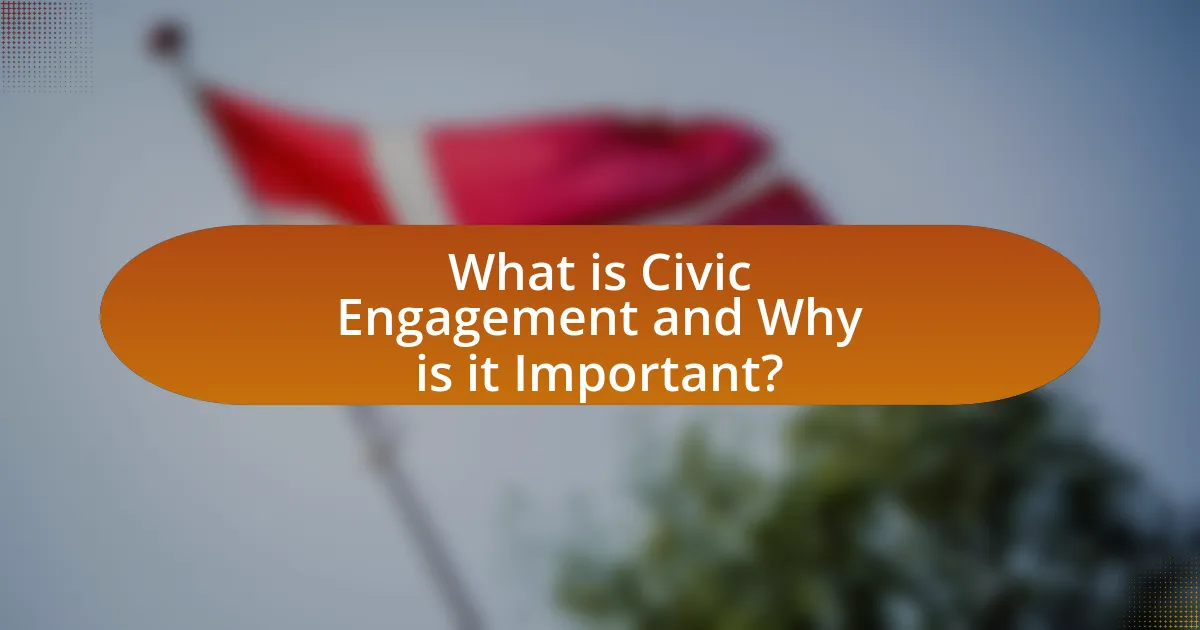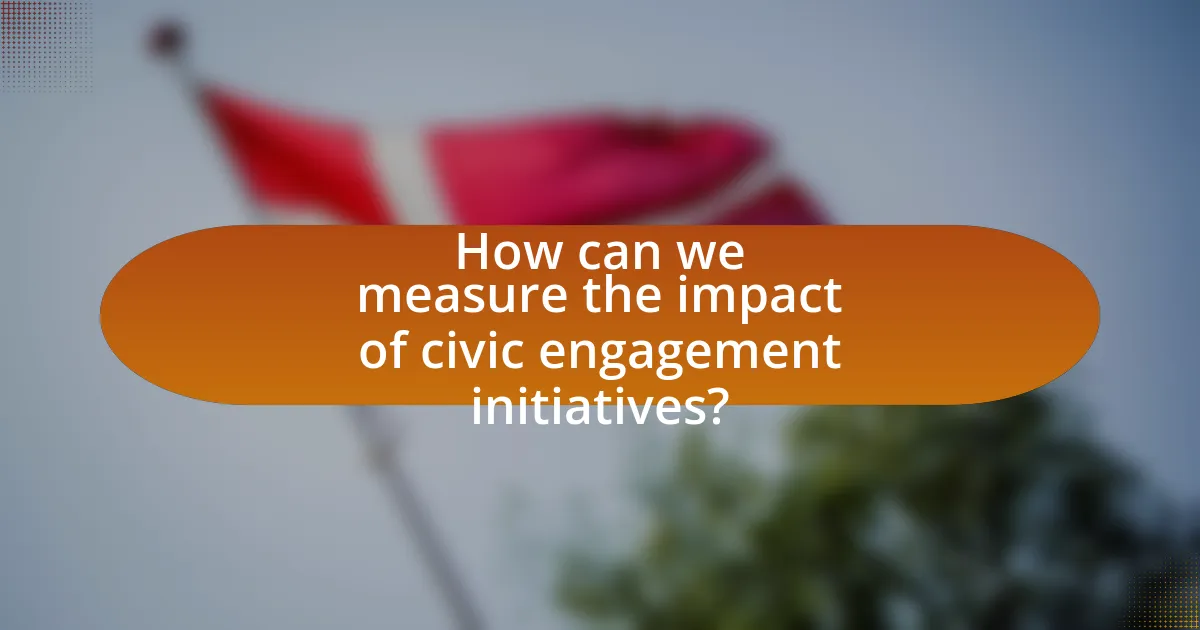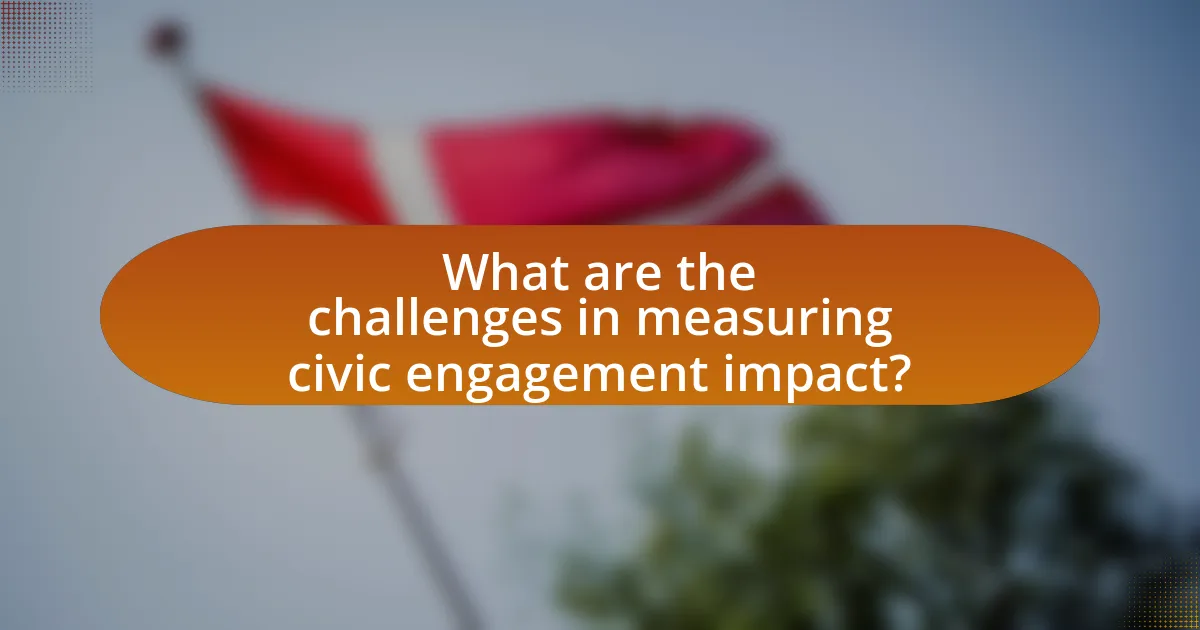Civic engagement refers to the active participation of individuals in political, social, and community processes that shape governance and public policy. This article explores the significance of civic engagement, highlighting its role in fostering community responsibility, improving governance, and enhancing social cohesion. It examines various forms of civic engagement initiatives, such as volunteer programs and advocacy campaigns, and discusses methods for measuring their impact through quantitative and qualitative metrics. Additionally, the article addresses challenges in data collection and evaluation, emphasizing best practices and the use of technology to effectively assess civic engagement outcomes.

What is Civic Engagement and Why is it Important?
Civic engagement is the active participation of individuals in the political, social, and community processes that influence governance and public policy. It is important because it fosters a sense of responsibility and ownership among citizens, leading to stronger communities and more effective governance. Research indicates that communities with higher levels of civic engagement experience improved social cohesion and better public services, as evidenced by a study from the National Conference on Citizenship, which found that civic engagement correlates with increased trust in government and higher voter turnout.
How do we define civic engagement?
Civic engagement is defined as the active participation of individuals in the political, social, and community processes that influence their lives and the well-being of their communities. This participation can take various forms, including voting, volunteering, attending public meetings, and advocating for policy changes. Research indicates that civic engagement fosters a sense of community and enhances democratic governance, as evidenced by studies showing that communities with higher levels of civic participation tend to have better public services and more responsive local governments.
What are the key characteristics of civic engagement?
Civic engagement is characterized by active participation in community and political processes. Key characteristics include awareness of social issues, involvement in community service, advocacy for change, and collaboration with others to address common concerns. Research indicates that engaged citizens are more likely to vote, volunteer, and participate in local governance, which enhances democratic processes and community well-being. For instance, a study by the National Conference on Citizenship found that civic engagement correlates with higher levels of trust in government and increased community cohesion.
Why is civic engagement essential for communities?
Civic engagement is essential for communities because it fosters active participation in decision-making processes, leading to improved governance and social cohesion. When individuals engage in civic activities, such as voting, volunteering, or attending community meetings, they contribute to a more representative and responsive local government. Research indicates that communities with higher levels of civic engagement experience better public services and increased trust in institutions, as evidenced by a study from the National Civic League, which found that engaged communities report 20% higher satisfaction with local governance. This active involvement not only empowers residents but also strengthens community ties, creating a more resilient and vibrant society.
What types of civic engagement initiatives exist?
Civic engagement initiatives can be categorized into several types, including community service projects, advocacy campaigns, public forums, and participatory budgeting. Community service projects involve individuals volunteering their time to improve local conditions, such as neighborhood clean-ups or food drives. Advocacy campaigns focus on raising awareness and influencing policy on specific issues, often through organized efforts like petitions or lobbying. Public forums provide platforms for citizens to discuss community concerns and engage with local leaders, fostering dialogue and collaboration. Participatory budgeting allows residents to have a direct say in how public funds are allocated, enhancing transparency and accountability in government spending. These initiatives collectively aim to enhance civic participation and strengthen community ties.
How do volunteer programs contribute to civic engagement?
Volunteer programs enhance civic engagement by fostering community involvement and encouraging active participation in societal issues. These programs provide individuals with opportunities to connect with their communities, develop a sense of responsibility, and contribute to local needs. Research indicates that participants in volunteer programs are more likely to vote, attend public meetings, and engage in community discussions, thereby increasing overall civic participation. For instance, a study by the Corporation for National and Community Service found that volunteers are 27% more likely to vote than non-volunteers, demonstrating a direct link between volunteering and civic engagement.
What role do advocacy campaigns play in civic engagement?
Advocacy campaigns play a crucial role in enhancing civic engagement by mobilizing individuals to participate in political processes and community issues. These campaigns raise awareness about specific causes, encouraging citizens to voice their opinions, vote, and engage in discussions that influence policy decisions. For instance, studies have shown that advocacy efforts, such as the “March for Our Lives” movement, significantly increased youth voter turnout in the 2018 midterm elections, demonstrating the effectiveness of targeted campaigns in galvanizing civic participation.

How can we measure the impact of civic engagement initiatives?
To measure the impact of civic engagement initiatives, organizations can utilize a combination of quantitative and qualitative metrics. Quantitative metrics may include participation rates, survey results, and demographic data, while qualitative metrics can involve interviews, focus groups, and case studies to assess community perceptions and changes in behavior. For instance, a study by the National Conference on Citizenship found that civic engagement initiatives can lead to increased voter turnout by up to 10%, demonstrating a measurable impact on civic participation. Additionally, tracking changes in community cohesion and social capital through pre- and post-initiative assessments can provide further evidence of the initiatives’ effectiveness.
What metrics are commonly used to assess civic engagement?
Common metrics used to assess civic engagement include voter turnout, participation in community events, and membership in civic organizations. Voter turnout is a critical indicator, reflecting the percentage of eligible voters who cast ballots in elections, which can be measured through election data. Participation in community events, such as town hall meetings or volunteer activities, can be quantified by attendance records and surveys. Membership in civic organizations, such as local advocacy groups or service clubs, can be assessed through membership counts and engagement levels, providing insight into community involvement. These metrics collectively offer a comprehensive view of civic engagement levels within a community.
How do we quantify participation rates in civic initiatives?
Participation rates in civic initiatives are quantified by measuring the number of individuals who engage in specific activities relative to the total eligible population. This can be achieved through surveys, attendance records, and registration data, which provide concrete metrics on involvement. For instance, a study by the National Civic League found that communities with structured outreach programs saw participation rates increase by up to 30%, demonstrating the effectiveness of targeted engagement strategies. Additionally, analyzing demographic data helps to understand who is participating and identify gaps in engagement, further refining the measurement of participation rates.
What qualitative measures can be used to evaluate civic engagement?
Qualitative measures to evaluate civic engagement include interviews, focus groups, and participant observation. Interviews allow for in-depth exploration of individual experiences and motivations related to civic activities, while focus groups facilitate discussion among participants, revealing collective attitudes and perceptions. Participant observation provides insights into behaviors and interactions within civic contexts, capturing the nuances of engagement. These methods are supported by research indicating that qualitative data can reveal the complexities of civic participation, such as emotional investment and community dynamics, which quantitative measures may overlook.
Why is it important to evaluate the effectiveness of civic engagement initiatives?
Evaluating the effectiveness of civic engagement initiatives is crucial because it ensures accountability and informs future strategies. By assessing these initiatives, organizations can identify what works, what doesn’t, and why, leading to improved participation and outcomes. For instance, a study by the National Civic League found that communities with evaluated civic engagement programs saw a 30% increase in citizen participation over three years, demonstrating the tangible benefits of such evaluations.
How does evaluation inform future civic engagement strategies?
Evaluation informs future civic engagement strategies by providing data-driven insights into the effectiveness of past initiatives. By analyzing participation rates, feedback, and outcomes, organizations can identify successful tactics and areas needing improvement. For instance, a study by the National Civic League found that communities that regularly assess their civic engagement efforts are 30% more likely to implement effective strategies in subsequent initiatives. This evidence demonstrates that systematic evaluation not only enhances understanding of what works but also guides resource allocation and strategic planning for future civic engagement efforts.
What are the consequences of not measuring civic engagement impact?
Not measuring civic engagement impact leads to ineffective resource allocation and missed opportunities for improvement. Without assessment, organizations cannot identify successful strategies or areas needing enhancement, resulting in continued investment in unproductive initiatives. For instance, a study by the National Civic League found that communities lacking data on civic engagement often struggle to mobilize citizens effectively, leading to lower participation rates and diminished community trust. This lack of measurement also hinders accountability, as stakeholders cannot evaluate the effectiveness of programs or justify funding, ultimately stalling progress in civic initiatives.

What are the challenges in measuring civic engagement impact?
Measuring civic engagement impact faces several challenges, primarily due to the complexity of defining and quantifying civic engagement itself. Civic engagement encompasses a wide range of activities, from voting to community service, making it difficult to establish standardized metrics. Additionally, the impact of civic engagement is often indirect and long-term, complicating the attribution of specific outcomes to engagement activities. For instance, a study by the National Conference on Citizenship found that measuring changes in community well-being or political participation as a result of civic initiatives requires longitudinal data, which is often scarce or difficult to collect. Furthermore, variations in local contexts and demographics can lead to inconsistent results, making it challenging to generalize findings across different communities. These factors collectively hinder the ability to accurately assess the effectiveness of civic engagement initiatives.
What obstacles do organizations face in data collection?
Organizations face several obstacles in data collection, including data privacy concerns, lack of standardization, and resource limitations. Data privacy regulations, such as GDPR, restrict how organizations can collect and use personal information, leading to challenges in obtaining necessary data. Additionally, the absence of standardized data collection methods can result in inconsistent data quality and comparability across different initiatives. Resource limitations, including insufficient funding and personnel, further hinder organizations’ ability to effectively gather and analyze data, impacting their capacity to measure the impact of civic engagement initiatives accurately.
How can biases affect the measurement of civic engagement?
Biases can significantly distort the measurement of civic engagement by influencing the data collection process and interpretation of results. For instance, selection bias may occur if surveys or studies predominantly include participants from specific demographics, leading to an unrepresentative sample that does not accurately reflect the broader population’s engagement levels. Additionally, response bias can arise when individuals provide socially desirable answers rather than their true feelings or behaviors, skewing the data. Research by the Pew Research Center indicates that self-reported civic engagement often overestimates actual participation rates due to these biases, highlighting the need for careful methodology in measuring civic engagement initiatives.
What are the limitations of existing measurement tools?
Existing measurement tools for assessing civic engagement initiatives often lack comprehensiveness, leading to incomplete evaluations. Many tools focus primarily on quantitative metrics, such as participation rates, while neglecting qualitative aspects like participant satisfaction and community impact. Additionally, these tools may not account for contextual factors, such as local culture or socio-economic conditions, which can significantly influence engagement outcomes. Research indicates that reliance on standardized metrics can overlook unique community needs, resulting in a one-size-fits-all approach that fails to capture the true effectiveness of initiatives. Furthermore, existing tools may suffer from biases in data collection methods, leading to skewed results that do not accurately reflect the engagement levels or impacts within diverse populations.
How can organizations overcome these challenges?
Organizations can overcome challenges in measuring the impact of civic engagement initiatives by implementing robust evaluation frameworks. These frameworks should include clear metrics for success, such as participant feedback, community outcomes, and engagement levels, which allow for quantifiable assessment. Research indicates that organizations employing structured evaluation methods, like the Logic Model, can effectively track progress and outcomes, leading to improved strategies and increased accountability. For instance, a study by the National Civic League found that organizations that utilized systematic evaluation reported a 30% increase in community engagement effectiveness.
What best practices can enhance data collection efforts?
Best practices that can enhance data collection efforts include clearly defining objectives, utilizing diverse data sources, ensuring data quality, and employing technology effectively. Clearly defined objectives guide the data collection process, ensuring that relevant information is gathered. Utilizing diverse data sources, such as surveys, interviews, and social media analytics, provides a comprehensive view of civic engagement initiatives. Ensuring data quality through validation and verification processes minimizes errors and enhances reliability. Employing technology, such as data management software and analytics tools, streamlines data collection and analysis, making it more efficient. These practices are supported by studies indicating that organizations that implement structured data collection strategies see improved outcomes in their initiatives.
How can technology aid in measuring civic engagement impact?
Technology aids in measuring civic engagement impact by providing tools for data collection, analysis, and visualization. Digital platforms enable the tracking of participation rates in civic activities, such as voting or community events, through analytics software that aggregates user data. For instance, social media platforms can quantify engagement through metrics like shares, likes, and comments, offering insights into public sentiment and involvement. Additionally, surveys and mobile applications can gather real-time feedback from participants, allowing organizations to assess the effectiveness of their initiatives. Research indicates that organizations utilizing technology for engagement measurement report improved decision-making and targeted outreach, enhancing overall civic participation.
What are some practical tips for measuring civic engagement impact effectively?
To measure civic engagement impact effectively, utilize a combination of quantitative and qualitative methods. Quantitative methods include surveys and metrics such as voter turnout rates, participation in community events, and social media engagement statistics, which provide measurable data on engagement levels. Qualitative methods involve interviews and focus groups that gather personal narratives and insights, offering depth to the understanding of civic engagement experiences. Research indicates that combining these approaches leads to a more comprehensive assessment; for instance, a study by the National Civic League found that communities employing mixed-method evaluations reported a 30% increase in understanding the effectiveness of their civic initiatives.


